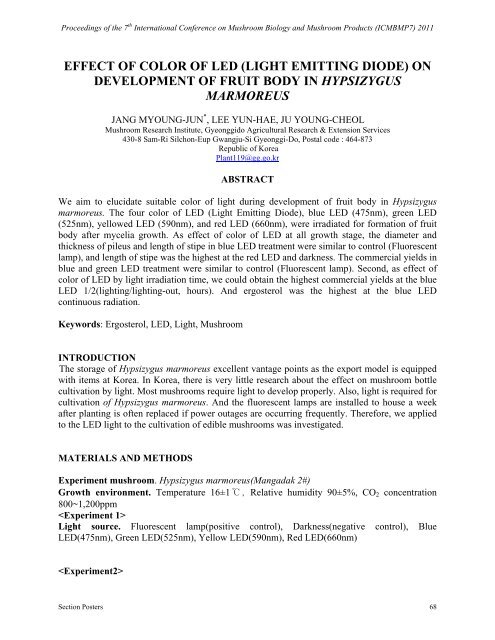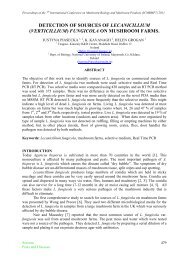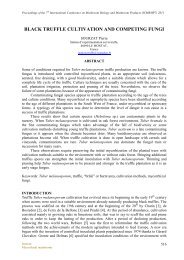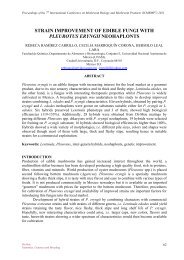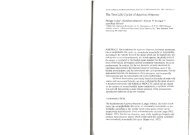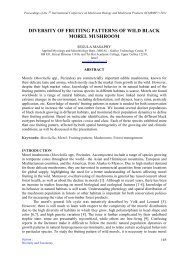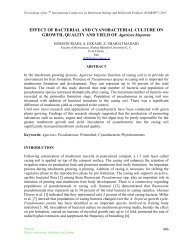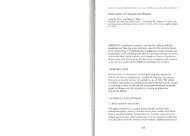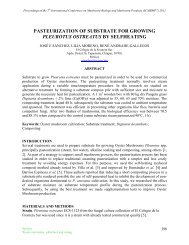Effect of color of LED (light emitting diode)
Effect of color of LED (light emitting diode)
Effect of color of LED (light emitting diode)
Create successful ePaper yourself
Turn your PDF publications into a flip-book with our unique Google optimized e-Paper software.
Proceedings <strong>of</strong> the 7 th International Conference on Mushroom Biology and Mushroom Products (ICMBMP7) 2011EFFECT OF COLOR OF <strong>LED</strong> (LIGHT EMITTING DIODE) ONDEVELOPMENT OF FRUIT BODY IN HYPSIZYGUSMARMOREUSJANG MYOUNG-JUN * , LEE YUN-HAE, JU YOUNG-CHEOLMushroom Research Institute, Gyeonggido Agricultural Research & Extension Services430-8 Sam-Ri Silchon-Eup Gwangju-Si Gyeonggi-Do, Postal code : 464-873Republic <strong>of</strong> KoreaPlant119@gg.go.krABSTRACTWe aim to elucidate suitable <strong>color</strong> <strong>of</strong> <strong>light</strong> during development <strong>of</strong> fruit body in Hypsizygusmarmoreus. The four <strong>color</strong> <strong>of</strong> <strong>LED</strong> (Light Emitting Diode), blue <strong>LED</strong> (475nm), green <strong>LED</strong>(525nm), yellowed <strong>LED</strong> (590nm), and red <strong>LED</strong> (660nm), were irradiated for formation <strong>of</strong> fruitbody after mycelia growth. As effect <strong>of</strong> <strong>color</strong> <strong>of</strong> <strong>LED</strong> at all growth stage, the diameter andthickness <strong>of</strong> pileus and length <strong>of</strong> stipe in blue <strong>LED</strong> treatment were similar to control (Fluorescentlamp), and length <strong>of</strong> stipe was the highest at the red <strong>LED</strong> and darkness. The commercial yields inblue and green <strong>LED</strong> treatment were similar to control (Fluorescent lamp). Second, as effect <strong>of</strong><strong>color</strong> <strong>of</strong> <strong>LED</strong> by <strong>light</strong> irradiation time, we could obtain the highest commercial yields at the blue<strong>LED</strong> 1/2(<strong>light</strong>ing/<strong>light</strong>ing-out, hours). And ergosterol was the highest at the blue <strong>LED</strong>continuous radiation.Keywords: Ergosterol, <strong>LED</strong>, Light, MushroomINTRODUCTIONThe storage <strong>of</strong> Hypsizygus marmoreus excellent vantage points as the export model is equippedwith items at Korea. In Korea, there is very little research about the effect on mushroom bottlecultivation by <strong>light</strong>. Most mushrooms require <strong>light</strong> to develop properly. Also, <strong>light</strong> is required forcultivation <strong>of</strong> Hypsizygus marmoreus. And the fluorescent lamps are installed to house a weekafter planting is <strong>of</strong>ten replaced if power outages are occurring frequently. Therefore, we appliedto the <strong>LED</strong> <strong>light</strong> to the cultivation <strong>of</strong> edible mushrooms was investigated.MATERIALS AND METHODSExperiment mushroom. Hypsizygus marmoreus(Mangadak 2#)Growth environment. Temperature 16±1℃, Relative humidity 90±5%, CO 2 concentration800~1,200ppmLight source. Fluorescent lamp(positive control), Darkness(negative control), Blue<strong>LED</strong>(475nm), Green <strong>LED</strong>(525nm), Yellow <strong>LED</strong>(590nm), Red <strong>LED</strong>(660nm)Section Posters 68
Proceedings <strong>of</strong> the 7 th International Conference on Mushroom Biology and Mushroom Products (ICMBMP7) 2011Light time. Continuous Light(control), 1/1(on/<strong>of</strong>f, hours), 1/2(on/<strong>of</strong>f, hours), 1/3(on/<strong>of</strong>f, hours),1/4(on/<strong>of</strong>f, hours), 1/5(on/<strong>of</strong>f, hours)* Experiment Light : <strong>LED</strong> Light selected at Experiment 1RESULTS AND DISCUSSIONFluorescent lamp Darkness Blue<strong>LED</strong> Green<strong>LED</strong> Yellow<strong>LED</strong> Red<strong>LED</strong>Figure 1: Primordia photographs under the <strong>LED</strong> <strong>light</strong> <strong>of</strong> Hypsizygus marmoreusTable 1: <strong>Effect</strong> <strong>of</strong> <strong>LED</strong> sources on properties <strong>of</strong> fruit body in Hypsizygus marmoreusLight source Diameter <strong>of</strong> pileus(mm) Thickness <strong>of</strong> stipe(mm) Length <strong>of</strong> stipe(mm)Fluorescent lamp 24a a 12a 79cDarkness 16c 10b 105aBlue<strong>LED</strong> 22a 12a 68dGreen<strong>LED</strong> 19b 10b 89cYellow<strong>LED</strong> 14c 10b 98bRed<strong>LED</strong> 16c 10b 103aa Values followed by the same letter do not differ significantly at p>0.05 according to Duncan's multiple range test.Table 2: <strong>Effect</strong> <strong>of</strong> <strong>LED</strong> source on yield properties <strong>of</strong> Hypsizygus marmoreusLight source No. <strong>of</strong> availablestipes(No./850ml)Yield(g/850ml)Commercialyields(g/850ml)Commercial yieldsIndex b (%)Fluorescent lamp 28 ab a 148 b 122 ab 82Darkness 31 a 156 a 114 b 73Blue<strong>LED</strong> 29 ab 159 a 135 a 85Green<strong>LED</strong> 35 a 158 a 130 a 82Yellow<strong>LED</strong> 28 ab 129 c 96 c 74Red<strong>LED</strong> 27 b 126 c 77 d 61a Values followed by the same letter do not differ significantly at p>0.05 according to Duncan's multiple range test.b Commercial yields / Yield × 100Section Posters 69
Proceedings <strong>of</strong> the 7 th International Conference on Mushroom Biology and Mushroom Products (ICMBMP7) 2011Fluorescent lamp Darkness Blue<strong>LED</strong> Green<strong>LED</strong> Yellow<strong>LED</strong> Red<strong>LED</strong>Fig 1: Morphological properties according to <strong>LED</strong> <strong>of</strong> Hypsizygus marmoreusTable 3: <strong>Effect</strong> <strong>of</strong> blue <strong>LED</strong> <strong>light</strong> irradiation time on properties <strong>of</strong> fruit body in Hypsizygus marmoreusLight irradiation time(<strong>light</strong>ing/<strong>light</strong>ing-out, hours)Diameter <strong>of</strong>pileus(mm)Thickness <strong>of</strong>pileus(mm)Thickness <strong>of</strong>stipe(mm)Length <strong>of</strong>stipe(mm)Fluorescent lamp 19 d a 7.0 d 11.3 b 82 bContinuous <strong>light</strong> irradiation 30 a 9.3 a 11.1 b 73 c1/1 25 b 9.0 a 11.9 a 73 c1/2 22 c 7.4 c 10.7 b 84 b1/3 26 b 8.6 b 12.1 a 82 b1/4 21 c 7.6 c 10.7 b 85 b1/5 18 d 6.4 d 10.9 b 93 aa Values followed by the same letter do not differ significantly at p>0.05 according to Duncan's multiple range test.Table 4: <strong>Effect</strong> <strong>of</strong> blue <strong>LED</strong> <strong>light</strong> irradiation time on yield properties in Hypsizygus marmoreusLight irradiation time(<strong>light</strong>ing/<strong>light</strong>ing-out, hours)No. <strong>of</strong> availablestipes(No./850ml)Yield(g/850ml)Commercialyields(g/850ml)Fluorescent lamp 36 a a 140 c 111 cContinuous <strong>light</strong> irradiation 22 c 169 a 130 d1/1 30 b 152 b 128 bc1/2 38 a 176 a 146 a1/3 31 b 148 bc 126 bc1/4 36 a 172 a 130 b1/5 38 a 177 a 120 ca Values followed by the same letter do not differ significantly at p>0.05 according to Duncan's multiple range test.CONCLUSIONS We selected blue <strong>LED</strong> that yield, commercial yields and commercial yieldsindex higher than these properties <strong>of</strong> the other <strong>LED</strong> treatment. We selected 1/2(<strong>light</strong>ing/<strong>light</strong>ing-out, hours) that yield and commercial higherthan these properties <strong>of</strong> the other <strong>light</strong> irradiation time.Section Posters 70
Proceedings <strong>of</strong> the 7 th International Conference on Mushroom Biology and Mushroom Products (ICMBMP7) 2011Fig 2: The ergosterol concentration <strong>of</strong> blue <strong>LED</strong> <strong>light</strong> irradiation time.ACKNOW<strong>LED</strong>GEMENTThis study was supported by research funds from RDA (Rural DevelopmentAdministration <strong>of</strong> Korea) (PJ0073112011)REFERENCES[1] Hideyuko, Y., Daisuke, M., Junji, H., Toshio, M. Kouzou, N. and Yasuo, O. (2005a). <strong>Effect</strong>s<strong>of</strong> wavelength <strong>of</strong> <strong>light</strong> on the bio-electric potential and the morphogenetic properties <strong>of</strong>Pleurotus eryngii. J. SHITA. 17(4):175-181.[2] Kaori, S., Katsunori, J., Koji, S., Hidehiko, N., Norimitsu, F., Toshio, O., Junji, H. andToshio, M. (2005b). Analysis on genes expressed during photomorphogenesis the fruitingbodies in Pholiota nameko. J. SHITA. 17(1):3-10.[3] Kengi, N., Satoshi, I., Kouichirou, M., Makoto, S. and Mitsuo, O. (2002). <strong>Effect</strong> <strong>of</strong> <strong>LED</strong><strong>light</strong>s on fruit-body production in Hypsizygus marmoreus. Mush. Sci. Biotech. 10:141-146.[4] Nunji, H., Daisuke, M., Yoshio, M. and Kouzou, N. 2008. Mushroom farming usingillumination control by synchronization with the spontaneous rhythm <strong>of</strong> the bio-electricpotential <strong>of</strong> Grifola frondosa(Maitake mushroom). J. SHITA. 20:90-97.Section Posters 71


